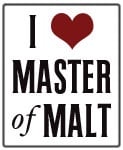 Monkey Shoulder
Monkey Shoulder "Triple Malt Scotch Whisky"
Vatted Malt
40% abv
£20.99
While last week had a Diageo bent, this week we'll look at a series of whiskies from William Grant and Sons (All WG&Sons tasted in the Malt Mission can be found HERE)
Created by David Stewart, Master Blender of Monkey Shoulder and Malt Master of Glenfiddich and Balvenie, "whose reputation for discovering fantastic objects of desire is world renowned," Monkey Shoulder is a "genuine modern classic." (quotes from the website). Monkey Shoulder is a vatting of different re-charred bourbon cask-aged whiskies from Glenfiddich, Balvenie and Kininvie. All three distilleries are located on the same large piece of land in Dufftown, Scotland. While you may have heard of the first two distilleries, it is unlikely that the third is familiar to many of you because it is not released as a single malt and is exclusively (?) used for Grant's blended whiskies, Gordon Highlanders, and Monkey Shoulder.
Clearly marketed as one for the style bars, Monkey Shoulder has done a masterful job of capturing the attention of men and women across Britain and America with nifty packaging and clever advertising. They have held a marketing campaign fostering associations with NME, Casinos/Poker events, fashion, and rock concert venues to address a "new generation of whisky drinkers." But does it work and is it good for whisky as a whole?
The goal of the marketing behind Monkey Shoulder has been to bring new drinkers to the category. According to MS Brand Manager Rob Curteis, "we first need to change people's perception of Scotch whisky." Now, I am not sure at what point the between emphasis on traditional floor maltings and the presence of ice and cocktail shakers William Grant and Sons thought they were changing anything but the perception of bartending. In a video readily viewable at the Monkey Shoulder website, we learn in a very effective and clear fashion how whisky is made, with cocktail interruptions to cater to the short attention span of this new generation of whisky drinksters. Between the New Orleans bitters, raspberry eau de vie, and lemon sugar, I am not clear what percetions of whisky were being changed. In fact, there seem to be more terminology and jingoisms to learn than any whisky stereotype out there. Triple Malt? Wort? Batch matured? SWA? Grain whisky? Oh, cocktails, there is a language I understand... duh!
The labelling is not just confusing with terminology, but is clearly trying to cash in with deception. Batch 27? Triple Malt? Both terms on the bottle to confuse the customer about age and superiority (oh, it is even BETTER than a single malt.. it is triple action!!!)

This is, at best, a campaign addressed at bartenders. By appreciating their craft, suggesting ways to use Monkey Shoulder in cocktails, sending them merch and taking them on trips and tasting tours, Monkey marketers are working to become a standard behind the bar. A tough sell, but it would be cool if it worked. But still, what about the customer who will have to ORDER this Banaynay Figtastic Monkeytini?
Dr. Whisky is more about diagnosis than commentary, and I am running out of time and patience, but I hope you can see what is wrong with each of the following taglines that are tossed around in Monkey marketing.
"Old school malt categorization is not what Monkey Shoulder is about"
"Matured to perfection"
"No grain whisky in monkey"
"Not the original whisky. More original than that"
Can the whisky just speak for itself without being a misleading monkey with a superiority complex, drowned in sugar and bitters, struggling to be "hip" and trendy, or degrading the integrity of scotch whisky traditions? Let's see what it has to say for itself.
TASTING NOTES:
Soft malt and vanilla sweet. Has that Glenfiddich pear, that Balvenie orange and honey, with some slight saltiness, green strawberries, bananas, licorice, and oak.
Creamy and sensuous in the mouth, baked, toasted and roasted, approaching smoky. Honey, spice, banana mash.
SUMMARY:
Balvenie tastes like the core of this flavourwise, with honey, spices, orange and beeswax, but the light estery features of young Glenfiddich (and Kininvie?) are perfectly used as the decoration. Well designed for new whisky drinkers and thoroughly enjoyable for the already initiated.
*** According to the website, Monkey Shoulder is ideal for mixing but is best savoured in a Brass Monkey: with ice and water. Now, as far as I am concerned that constitutes mixing, but lets try it this way and see what goes on...
TASTING NOTES:
More cardboard and root vegetables emerge with ice. Scotch broth, barley, and shortbread. Dead and drying nose.
Soft, vanilla, pastry. Unoffensive, but uninteresting.
SUMMARY:
The dusty storage room features are much stronger with ice both in the nose and on the palate. The delicate charm is all lost and the sexy mouthfeel is sacrificed to the cold ice. Extremely tasty at 40% without ice or ginger ale or fig brandy or ... As I said above, very well made whisky that deserves to be consumed straight out of the bottle and enjoyed by whisky drinkers new and old.
Malt Mission #111
Malt Mission #113
Malt Mission #114
Malt Mission #115
Malt Mission HOME





No comments:
Post a Comment